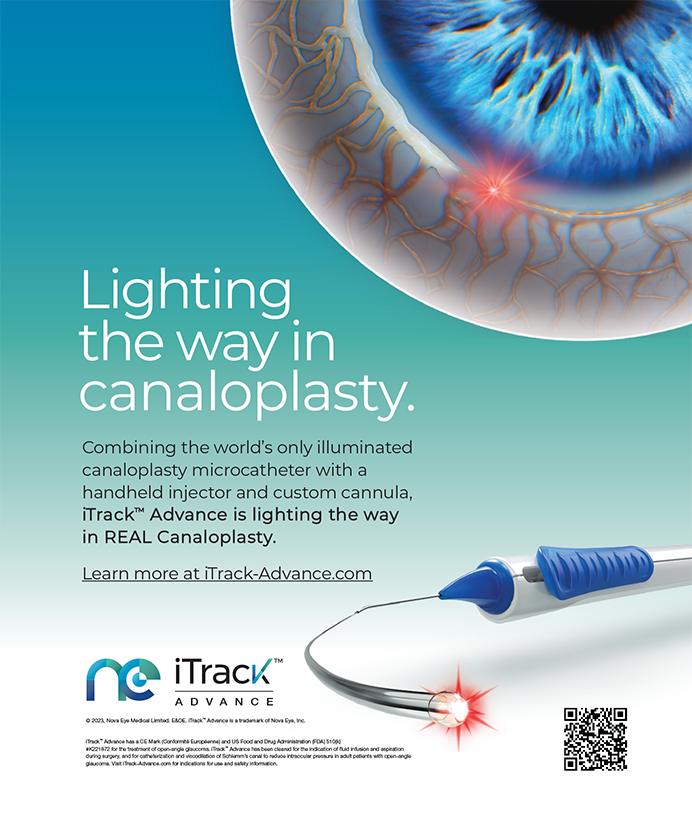The most common complication following PRK is subepithelial fibrosis with wound healing. At slit lamp examination, this complication appears opaque, shows variable density, and is commonly labeled as haze. Certain circumstances tend to amplify both haze density and development. Among them, the degree of intended correction is probably the most important factor: the higher the correction, the higher the chance that haze will form. However, other factors such as UV exposure, delayed re-epithelialization, or an irregular ablation surface, are also implicated in haze formation. Dense haze may significantly reduce best spectacle-corrected visual acuity (BSCVA), induce regression and irregular astigmatism, and provoke visual symptoms such as blurred vision, haloes, glare, and ghost images. In treating severe haze, topically applied pharmaceuticals such as corticosteroids are often ineffective, as is therapeutic laser ablation, because haze usually results from laser ablation.
Lost in a Haze
The worst case of haze I have ever seen was in a male who was referred to me 2 years after undergoing bilateral myopic PRK for -12.00 D. The opacity in both of his eyes was so dense that it obscured the iris details at slit lamp examination, and the scarring was so severe that it induced marked irregular astigmatism on his corneal topography. In both eyes, BSCVA was 20/40 (preoperative BSCVA was referred as 20/16) with -4.75 D in the right eye and -4.50 D in the left, while the patient's uncorrected visual acuity was 20/800 in both eyes. The patient's haze reportedly appeared 1 year postoperatively, immediately following a long vacation that he had taken during the summer, in a country with high UV exposure. The patient's uncorrected and BSCVAs prior to the onset of haze were 20/16 in both eyes, with (amazingly!) a plano refraction. Immediately after the haze appeared, both eyes were treated for 6 months with high dosage topical corticosteroid eye drops (dexametazone 4 times daily), which was ineffective in reducing the haze and reversing the patient's myopic regression.
A Kinder approach
At that time, the patient was on a relatively long waiting list for lamellar keratoplasty at another center, so I decided to try to manage this challenging case. I opted to surgically treat the corneal scarring by first scraping it away, and then by applying a diluted 0.2 mg/mL (0.02%) mitomycin C (MMC) solution to inhibit further haze formation.
I topically applied a 20%-diluted alcohol solution by filling the barrel of a 9.0-mm Hoffer marking trephine. I absorbed the alcohol and then gently removed the epithelium using a Merocel® eye spear (Medtronic Solan, Jacksonville, FL). Once the epithelium was taken off, the central scarring was clearly visible. Using a Desmarres sharp blade, I scraped the stromal surface quite vigorously in an attempt to eliminate as much of the newly generated tissue as possible. This process took more than 3 minutes, and concluded when I could no longer see material on the sharp edge of the blade. At that point, the stromal surface appeared more transparent, as well as much more smooth and regular.
Immediately after scraping, I placed a circular Merocel® eye spear soaked with 0.02% MMC solution on top of the stromal surface, and left it in place for 2 minutes. I then irrigated the surface copiously with 20 mL BSS® (Alcon Laboraties, Inc., Fort Worth, TX) to remove all MMC particles and remnants.
A Diligent Follow-up
Postoperatively, I applied a bandage contact lens to both eyes and left them in place for 4 days until re-epithelialization was complete. During this period, antibiotic drops and nonsteroidal anti-inflammatory drops were applied four times per day, in addition to artificial tears. The patient was also prescribed oral narcotics as needed for pain. Once the bandage contact lenses were removed, topical fluorometholone drops were applied 4 times per day for 1 month, and then twice per day for 2 weeks. Artificial tears were administered as needed thereafter.
During the re-epithelialization period, I evaluated the patient's eyes daily for possible toxic effects, and I could already see great improvement in corneal transparency. I did not see any toxicity or side effects such as conjunctival chemosis, delayed re-epithelialization, or epithelial irregularity.
A Happy Ending
One month following treatment, the corneas of both eyes were completely transparent. In both eyes, uncorrected and BSCVAs were 20/20, with +0.25 D refraction. Corneal topography mapping revealed a significantly irregular surface, with no irregular astigmatism. These findings did not change over a 2-year follow-up period. The eyes maintained corneal transparency, and haze did not recur. The patient's uncorrected and BSCVAs, as well as his refraction, remained stable. No long-term toxic effects such as corneal melting or endothelial changes occurred. Due to the success of this treatment, the patient avoided lamellar keratoplasty.
Stromal scraping and the topical application of MMC proved very effective in removing severe haze in this patient. All related side effects, such as myopic regression, visual acuity loss, and irregular astigmatism were eliminated. Based upon this experience, I have since treated more than 40 eyes presenting with severe haze formation with this approach, and the results have been similar to those presented here. This approach may be useful for refractive surgeons facing such complications following PRK.
To Keep In Mind
For surgeons considering this technique, I would make a recommendation regarding the use of MMC. Its therapeutic safety concentration window is very tight: a lower concentration than 0.02% may be ineffective, whereas a higher one may have toxic effects. Additionally, exposure for less than 2 minutes may not be enough to produce a therapeutic effect, whereas a longer application time may induce toxic side effects. In conclusion, I believe that this therapy should be considered prior to more invasive approaches, such as keratoplasty, and in all cases in which severe haze formation produces visual acuity loss and subjective visual disturbances after excimer laser PRK.


